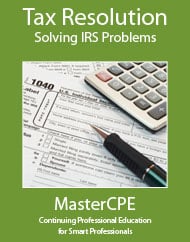Course Information
A Guide to Tax Resolution: Solving IRS Problems
Course Information
| Title: | A Guide to Tax Resolution: Solving IRS Problems |
|---|---|
| Category: | Taxation |
| Field of Study: | Taxes |
| Course Code: | M212 |
| CPE Credits: | 7.0 |
| Price: | 54.95 |
Description
Description:
The IRS, one of the world’s largest tax administrators, collected about $4.7 trillion in taxes from 275 million annual returns in FY 2023. However, with an estimated $574 billion in back taxes uncollected in 2023, the IRS, also the world’s largest collection agency, actively seeks payment of tax debts. The IRS can collect back taxes for 10 years from the date of assessment. To collect delinquent tax debt, the IRS may take a series of actions, such as filing a Notice of Federal Tax Lien, levying assets (e.g. wages, bank accounts), and offsetting federal tax refunds, unless taxpayers make arrangements to settle their debt. Tax resolution is the process of developing and implementing a solution to solve a taxpayer’s IRS problem.
Since every tax situation is unique, this course is designed to help you understand several methods used by tax professionals to resolve tax disputes with the IRS and reduce tax liabilities allowed by law. It is divided into five parts. Part I identifies taxpayers’ rights and responsibilities under the law. It discusses the role of taxpayers and the “Taxpayer Bill of Rights” by describing what taxpayers can expect if they need to work with the IRS. Part II explores practical options, such as payment plans, Offers in Compromise, and delay collection request, for taxpayers who cannot pay in full immediately. It also identifies common reasons the IRS might consider penalty abatement. The statute of limitations on a tax debt is explained.
Part III focuses on IRS collection actions. It explains how the IRS determines taxpayers’ ability to pay delinquent tax liabilities. It also covers everything taxpayers need to know about lien and levies from the IRS filing criteria, procedures, consequences, and how to remove them. Part IV addresses the IRS long-term payment plan (Installment Agreement) by explaining different payment options, ways to apply, and how to deal with defaulted payment plans. Part V discusses how to settle taxes with Offers in Compromise by explaining submission rules, how to prepare a Collection Information Statement, and the IRS evaluation process. The course includes many examples to help you understand tax rules and procedures.
Delivery Method: Online Interactive Self Study
Level: Overview
Prerequisites: None
Advanced Preparation: None
Course Details
Category: Taxation
Field of Study: Taxes
Passing Score: 70%
Technical Details: Taxation is a technical field of study for all states.
For More Detail:
If you are unable to view PDF then right click the mouse and click save link as
Objectives
Objectives:
Part 1: Recognize Taxpayer Rights and Responsibilities
- Identify tax responsibilities and taxpayer rights
- Recognize IRS obligations to protect the Taxpayer Bill of Rights
- Identify criteria for taxpayer assistance from the Taxpayer Advocate Service
- Recognize how the Taxpayer Advocate Service exercises its statutory authorities
Part II: Interact with the IRS
- Recognize the IRS Temporarily Delay the Collection Process
- Identify requirements for IRS Currently Non-Collectible Status
- Recognize the innocent spouse rule
- Recognize the effect of bankruptcy on taxes
- Identify IRS penalty abatement criteria
- Recognize the time the IRS can assess and collect taxes
Part III: Understand Enforced Collection Actions
- Identify the IRS process for determining taxpayers’ ability to pay
- Recognize different ways to get federal lien releases
- Identify the IRS tax levy policies and procedures
- Recognize the right to appeal an IRS decision
Part IV: Make Payments Over Time
- Identify different types of IRS payment plans and the terms of agreements
- Recognize the consequence of noncompliance with the terms of agreements
Part V: Settle Taxes with Offer in Compromise
- Identify types of IRS Offer in Compromise
- Recognize conditions required for an IRS to accept a compromise
- Identify terms and conditions of the acceptance agreement
- Recognize key factors used by the IRS to determine taxpayers’ ability to pay
For More Objectives:
If you are unable to view PDF then right click the mouse and click save link as
Profession
NASBA: Yes
QAS: Yes
CPA: Suitable for all CPAs
IRS: IRS credit for Enrolled Agents.
Profession Identifiers: CPA, EA

